#horriblehistories
Explore tagged Tumblr posts
Photo


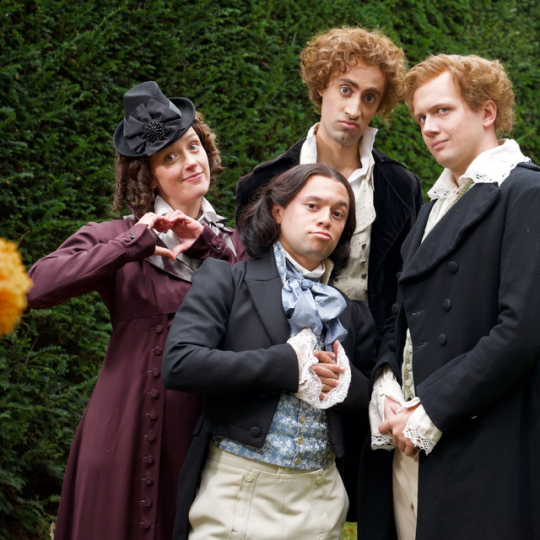
This purple coat with a leather collar was created for Lily James to wear as Elizabeth Bennet in the 2016 adaptation of the Seth Grahame-Smith novel 𝑷𝒓𝒊𝒅𝒆 𝒂𝒏𝒅 𝑷𝒓𝒆𝒋𝒖𝒅𝒊𝒄𝒆 𝒂𝒏𝒅 𝒁𝒐𝒎𝒃𝒊𝒆𝒔. The coat was seen again in the 2019 eighth season of 𝑯𝒐𝒓𝒓𝒊𝒃𝒍𝒆 𝑯𝒊𝒔𝒕𝒐𝒓𝒊𝒆𝒔, where it appeared on Jessica Ransom as Mary Shelley in 𝑻𝒉𝒆 𝑹𝒐𝒎𝒂𝒏𝒕𝒊𝒄 𝑷𝒐𝒆𝒕𝒔 𝑺𝒐𝒏𝒈. Finally in 2022 it was spotted in the second season of 𝑺𝒂𝒏𝒅𝒊𝒕𝒐𝒏, where it was worn by Charlotte Spencer as Esther Denham. Where do you think this costume will appear next? Bit.ly/RegRom197
#MovieCostumes#TVCostumes#PrideandPrejudiceAndZombies#LilyJames#HorribleHistories#TheRomanticPoetsSong#JessicaRansom#Sanditon#CharlotteSpencer#FashionInFilm#IconicLooks#FilmAndTVFashion#RecycledMovieCostumes
196 notes
·
View notes
Text
77Tij6;LBV+AP^6+<_mO

Welcome to the official (Well, as official as an AU can get) Naughty Napoleon blog! You may wonder what Naughty Napoleon is besides the Horrible Histories special episode. This is a Horrible Histories half-horror (most of the lore is ooky spooky but most of the other stuff is goofy) AU that mainly focuses on the Gorgeous Georgians and Fabulous French eras, especially focusing on the sketch "Le Survival Guide" (Go check it out Benoit needs some more attention). WARNINGS FOR THE AU: - General Horror - Body horror/unrealistic gore - Murder - Existential/psychological stuff (maybe idk I'm not the best at giving warnings) - Potentially nonsensical lore, the rare ship (they aren't that important in this au, just a random little "oh btw-" for goofy shenanigan parts of it), general cringe (Please note this au is simply made by some friends for fun) This au is also technically a part of a larger multiuniversal project me and my friends are constantly working on, but don't worry this blog is only going to focus on Naughty Napoleon.
#naughty napoleon#naughtynapoleon#horriblehistoriesau#horriblehistories#horror au#blog intro#horrible histories au#horrible histories
8 notes
·
View notes
Text

Dont ask me why...(maybe because I'm a Fantasy-Freak)
but I have always thought that Ben Willbond needs more fantasy roles in his portfolio.
Here's a little edit i made to prove it. Who's with me?
*respectfully of course*
credits to digitalart_4readers for the original edit (Xaden Riorson - Fourth Wing)
#benwillbond#ben willbond#bbc ghosts#ghosts#hire him#please#respectfully of course#them there#six#horriblehistories
12 notes
·
View notes
Video
youtube
Horrible Historie made “The Addams Family”’s parody and I LOVE IT.
2 notes
·
View notes
Photo

I'm watching Horrible Histories 2x04 "Episode 4"
0 notes
Text
i bought an army for fighting spartacus / at the start my men lost heartacus............
13 notes
·
View notes
Text
Forgotten for Football: The Horrific Thanksgiving Day Disaster of 1900
Since the late 1800s Thanksgiving and football have gone hand in hand with the fevered fanbase and anticipation staying strong over the centuries. The first college football game was played on Thanksgiving Day 1876 as part of the Intercollegiate Football Association Championship, and it did not take long for fans to choose their sides. By the time 1900 appeared on calendar pages the University of California Berkeley and Stanford University were already fierce rivals, playing against each other every Thanksgiving since 1892 in a clash that became affectionately known as simply “The Big Game.” People always had high expectations for the game, but no one walking into the event ever expected to encounter tragedy.
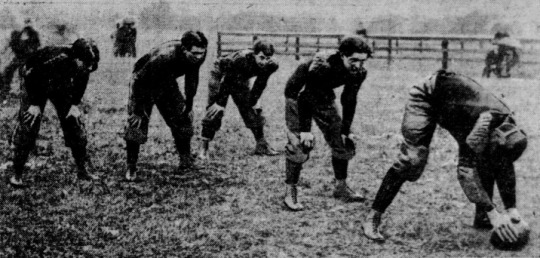
The Stanford University football team circa 1900. Image via Wikimedia Commons.
No one can say the warning signs were not there. In the early days of the game there were no stadiums and it was played in any large field or industrial area that could fit them. The last few Big Game events between University of California Berkeley and Stanford were played at Recreation Field in San Francisco and in 1897 grandstands were built to accommodate the crowds. These seats were not meant to last, they were built quickly to fit 10,000 people with meager roofs that were only put there to keep spectators dry and definitely not to be used for extra seating. But, that is exactly what happened in 1897. While over 15,000 people scrambled and squeezed into the stands to see the game many others looked for alternative means to watch. Contractor J.C. Weir saw the danger and tried to warn those in charge, but his words were ignored while waves of young boys climbed up the stands and crowded the roofs to set their eyes on the teams below. They almost made it through the entire game, but in the final moments the roofs began to buckle, and then they broke. Hundreds of children came crashing down onto those seated below them, intermingled with the wood and metal that was never meant to hold their weight. Some people were knocked unconscious, some were left bleeding but remarkably only one 10-year-old-boy was injured enough to seek medical care and everyone else was, for the most part, left unscathed. One witness to the collapse remarked that the fact that no one was killed or left with permanent injuries was “miraculous”, and indeed it was, but not enough for anyone to learn from it.
The collapse of the grandstands was the last thing on the minds of the attendees of the Big Game taking place on November 29th 1900. The games were always exciting and even though the tradition was fairly new, by 1900 the crowds were massive and the tempers hot despite the teams only having a history of nine Big Game encounters. Of the nine games, Stanford had won seven despite their football team only being founded the same year as their first game and tens of thousands of people couldn’t wait to see if University of California Berkeley would come roaring back. Like previous years, the game was to take place in San Francisco, and once again no one could have anticipated the sheer size of the crowd. It had rained earlier that morning, but when the weather passed the doors of the surrounding neighborhoods and the incoming train cars were swinging open leading to 19,000 people swarming Recreation Field by 10:30am. A ticket for the game cost one dollar, an amount that wasn’t an easy price for many younger fans that desperately wanted to watch the biggest event of their year. So, just as they did several years earlier, the fans got inventive. Some climbed water towers, others tried to dig under fences to get in, but there was one thing that seemed to be an obvious solution for those needing a bird's eye view of the Big Game.
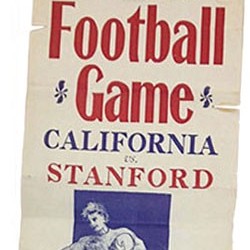
Flyer for the Big Game on November 29th 1900. Image via Stanfordmag.org.
Across from Recreation Field was San Francisco and Pacific Glass Works, a brand new factory that was gearing up to open on December 3rd. Those putting up the makeshift grandstands remembered the collapse of 1897 and they told those in charge of the factory that they were required to do everything possible to prevent anyone from gathering on the roof. The Superintendent of the factory James Davis was in complete agreement with precautions being taken and he was given six tickets to the game for his compliance, but when the time came the workers that were stationed to prevent anyone from getting on the roof were simply overwhelmed. People dug under fences to get to the grounds, flung open the gates, and they poured in. According to one witness, “It was like trying to turn back the waves at the beach. The kids kept pouring through the fence anxious to see the kickoff." Factory workers who could sense the danger went into the streets, looking for police officers to help control the crowd and get the people off the roof but they could not find anyone who could assist. Soon between 500 and 1000 people were crammed onto the factory roof that was only built to withstand forty pounds per square inch. Even if someone wanted to escape it was impossible to move through the crowd to do so. They all gazed ahead, not paying any attention to the tell-tale signs around them signaling the danger they were all in.
Twenty minutes into the game the crowds in the stands were electric. Their voices were roaring and the bands for Stanford and University of California Berkeley were booming, beating the thousands into a frenzy. The atmosphere on top of the glass works building was just as ecstatic, but in a matter of seconds it shifted to chaos. A portion of the roof of the building gave way and in a scene that was unfortunately familiar the fans began to fall. But, unlike the collapse of 1897 that had relatively minor injuries, this time the spectators fell into an absolute nightmare.
This building was a glass factory, and although it was not due to officially begin production just yet, it was partially operational in preparation for the opening day. One thing that was up and functional was a furnace, filled with fires strong enough to melt glass and with an exterior temperature of approximately 500 degrees. Working in the factory that day were Ignace Jocz and Clarence Jeter, and they could undoubtedly hear the roars of the crowd before humanity started to unexpectedly rain down on them from above. The hole in the roof opened at the worst possible spot and between sixty and one hundred people fell forty-five feet into the factory with some of them landing directly on top of the glowing furnace.
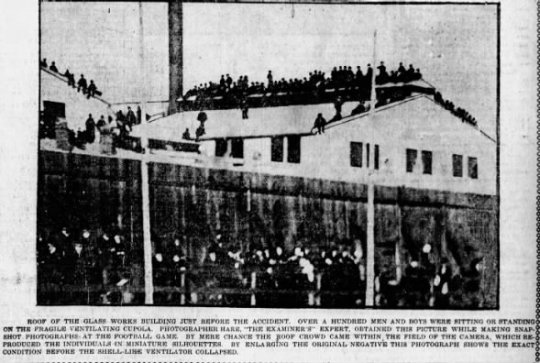
Image of the roof of the factory just before the accident. Image via 30 Nov 1900, Fri The San Francisco Examiner Newspapers.com
It's impossible to imagine the scene and the sounds that filled the factory as they all hit the metal or, if they were lucky, the brick floor. Once they hit most broke enough bones to render them immobile and those that hit the furnace stuck to the sizzling top. To make things even worse the furnace was encased by binding rods surrounding the machine in what was essentially a cage, trapping anyone who fell in the spaces. Those who missed the cage were just as unlucky, some of the falling bodies struck fuel pipes on their way down, severing them and sending boiling oil through the air and dousing the already burning bodies that then exploded into flame. Adding to this already unimaginable tragedy was the fact that almost everyone who plummeted through the ceiling that day were children, some boys as young as nine years old, that were the most likely to not have the dollar to buy a ticket and the least amount of concern about climbing to the roof of a building to watch the game.
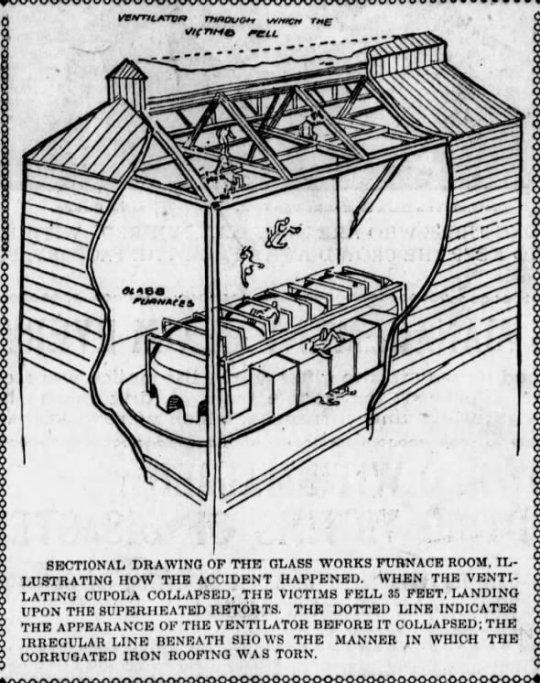
Illustration of the inside of the factory showing the furnace and binding rods. Image via 30 Nov 1900, Fri The San Francisco Examiner Newspapers.com.
Jocz, Clarence, and some other employees of the factory jumped into action doing what little could be done to attempt to save some of the victims, grabbing bodies and throwing them out of the way and using long metal hooks that were normally used to stir molten glass to hook people that landed on the furnace and drag them down. Watching the horrific scene from above were approximately twenty-seven people who also fell through the ceiling but somehow were able to cling to the rafters and the walls to avoid being roasted alive. One witness, young Thomas Curran, survived the ordeal by grasping a ceiling joist with his legs, forced to hang upside-down while chaos erupted under him. He later stated: “As I clung there, I saw the poor fellow who had been chatting with me strike the furnace. He curled up like a worm in that heat.” The sound of the bands and cheers of the game could still be heard filling the air.
Incredibly, the crowds gathered to watch the Big Game were greatly unaware of the tragedy unfolding nearby. Spectators heard the crash but some believed it was simply a planned distraction by the opposing team, with one fan yelling “It’s a job!” Others believed it was just normal sounds coming from the industrial park and within moments the focus was back on the field. Those who did know that something was amiss were the residents of the surrounding towns and they quickly began to swarm the factory, screaming the names of their sons who had gone off that morning to enjoy a football game. The masses also ran to the morgue and toward the wagons being driven by the coroner, some filled with bodies burned and disfigured beyond recognition and others filled only with what remained such as socks, shoes, neck ties, and the contents of small pockets. Every possible vehicle was summoned to help, and a frantic search began for doctors that could be pulled away from their Thanksgiving meals to help the deeply wounded masses that lay on the factory floor in sheer agony while the smell of burning flesh filled the air. As the players from Stanford were marched out onto the street for an impromptu victory parade to the nearby Palace Hotel, other streets were filled with the screams and frenzy of the tragedy that seemed to have happened in another world from the game that happened only two blocks away.
As the news spread that day as to what happened and the numbers began to rise the city was plunged into a deep state of sorrow. Hospitals became overwhelmed and the official count declared that thirteen people had died in the factory with eighty-six others critically wounded. As more recovered, others still died and soon the funerals began. On the following Sunday alone there were nine burials that had to take place back-to-back from 9am to 4pm.
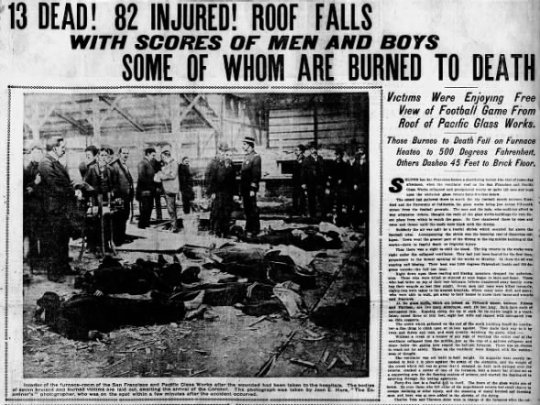
Newspaper story about the accident. Image via 30 Nov 1900, Fri The San Francisco Examiner Newspapers.com.
Amazingly, reactions to what happened remained as separated in the newspaper pages as they did on the streets the day of the tragedy. The cover of the New York Times talked about the horror of the deaths at the glass factory, but the Sports section beamed of the Stanford victory as if nothing else had happened that day, calling the game the “closest and most exciting game of football ever played by the elevens of the two California universities." No players or coaches commented on the unspeakable horror that unfolded within earshot of the game that day. The college publications from both Stanford and University of California Berkeley carried on as if it never even happened with the Stanford Daily writing a 1,500-word front-page story about the victory with no mention of the tragedy other than a casual mention of a potential rematch to raise money for the affected families that never ended up happening.
Although the city of San Francisco felt the deaths deeply, it seemed they too wanted to move beyond it as quickly as possible. When a grand jury was assembled to determine who was at fault for the Big Game disaster it had an air about it that seemed like it was purely for appearances. The blame was placed on James Davis as the Superintendent of the San Francisco and Pacific Glass Works and then it shifted to the police for not assigning enough people to the game. Shockingly, with no one to blame and people wanting to simply move on, the blame shifted to the dead. Seven days after the tragedy, and with victims still succumbing to injuries, the jury declared that “[T]he deceased had no business being there...No one can be held responsible for their deaths other than themselves." No one fought them on this. In the minds of most, the story of the collapse was over.
The newspapers and courts might have decided the case was closed, but for many what happened that day never went away. On December 4th 1900 young Fred Lilly died in the City and County Hospital after suffering for months from a fractured skull he sustained in the fall. He never fully regained steady consciousness but in moments of delirium he still acted as if he was watching and enjoying the football game that was playing in front of him before everything suddenly stopped. Three years after the roof collapse twenty-eight-year-old Thomas Pedler passed away after enduring spinal surgery, paralysis, and the amputation of both legs. His demise marked the twenty-third and last death resulting from the disaster, fifteen of which being children that died before their eighteenth birthday.
To this day the tragedy, known now as the Thanksgiving Day Disaster or The Big Game, is the deadliest accident to ever happen during an American sporting event. Now the glassworks building is gone, replaced with a building belonging to the University of California. The gravestones are also gone and most of the final resting places of victims disappeared from memory and fell into ruin after San Francisco introduced regulations forbidding new burials, also in the year 1900. One small reminder of the incredible catastrophe can be found in the Holy Cross Catholic Cemetery just south of the city. Here lies a tiny stone cross that was meant to only be a temporary marker. It is inscribed with the name Cornelius McMahon, a twelve-year-old boy who died in the Thanksgiving Day Disaster and now remains as the only physical reminder of the deadliest day in American sports history.
*****************************************************
Sources:
“The Big Game Disaster of 1900” by Sam Scott. Stanford Magazine November/December 2015.
“Big Game was marred by tragedy in 1900 contest” by Edvins Beitiks. November 17, 1997.
“The Thanksgiving Disaster that Most People Haven’t Heard About” by Marina Manoukian. November 19, 2022.
“Sudden Death: Boys Fell to Their Doom in S.F.'s Forgotten Disaster” by SR Weekly Staff. Aug 15, 2012.
“Thanksgiving Day Tragedy” ThePigskinDispatch.com
https://pigskindispatch.com/home/Football-Fun-Facts/Random-Football-Facts/Stadium-Disasters/Stanford-Vs-Cal-1900-Tragedy
#HushedUpHistory#featuredarticles#history#CaliforniaHistory#SportsHistory#tragichistory#horriblehistory#Footballhistory#TheBigGame#ThanksgivingDayDisaster#historyclass#strangehistory#forgottenhistory#tragictale#truestory
2 notes
·
View notes
Text
Hellooo everybody!!. Here are the 64 tournament blogs chosen.
Below the cut of course
@ao3topshipsbracket
@autismswagsummit
@best-kirby-character-tournament
@best-tournament-blog-bracket
@bestfictionaldinosaur
@besttropeveershowdown
@bl-bracket
@champsinthemaking
@companion-showdown
@controversial-blorbo-bracket
@dysfunctional-family-fight
@fandom-march-madness
@fictional-gods-tournament
@fictional-twink-bracket
@foodfightbrackets
@freaky-fellers-tourney
@fuck-you-upmusicbracket
@gay-disabled-characters-showdown
@gimmick-blog-bracket
@girllbossmalewifeduos
@goverment-agency-bracket
@guess-that-ship
@specificpollsaboutbooks
@humancelltournament
@horriblehistories-shabbyshowdown
@hot-take-tournament
@its-to-the-death
@mcytblingsbracket
@misrepresentedmorallygrey
@most-tragic-character-tournament
@mosthuggableffxiv
@mythologyolympics
@npd-characters-tournament
@ourpokemonteamtournament
@outfitpolls
@pennysperfectpolls
@pokemonbattletournament
@pokemonunderdogtournament
@pokepollsters
@pollsonmorenichetopics
@princesspoll
@quote-tournament
@sea-creature-tournaments
@sexiestpodcastcharacter
@sexyman-de-lempire-tournament
@ship-colour-scheme-showdown
@strangest-blorbo-tourney
@surprise-its-polls
@tbcu-polls
@the-owl-house-blorbo-brawl
@theultimatejackoff
@tourneys-by-me
@ultimate-character-design
@ultimatepokemontournament
@underratedmhapoll
@undertale-ost-tournament
@variouspolltournaments
@vgtrackbracket
@weeb-polls-with-pip
@who-do-i-know-this-man
@who-do-i-know-this-man-s4
@worst-fictional-places-to-work
@yall-hate-kids-tourney
@yen-sids-tournament
390 notes
·
View notes
Text
My propaganda 🤑🤑🤑 @horriblehistories-shabbyshowdown

Text (for copy and paste and because my handwriting is shit and I wanna paraphrase mineself)
-He had a very good sense of fashion (friends with Beau brummel)
-Made buckingham palace (supported other works of architecture aswell!)
-Good with the ladies (rizz)
-He may have been an obnoxious alcoholic but it’s merely due to the fact that those with the strictest parents tend to rebel more often. George got whipped hundreds of times for the littlest of things!
-He may have cheated on his wife COUNTLESS times, but you’d cheat on your wife too if you hated her AND she was your cousin.
-Heavily supported the royal collection! (AKA the worlds largest and most important collection of clothing items, pottery, sculptures and paintings)
-GYATT ‼️‼️
Summary/non bullet point: George IV heavily sponsored major works of architecture such as the Buckingham Palace, aswell as major art and artifact collections such as the Royal Collection (Largest and most important historical artifact and painting collection in the world). He also had an impeccable fashion sense- he was friends with Beau Brummel after all (atleast for some time). And what he did in life that wasn’t so good- that’s a known fact- however, when you consider George III was heavily strict and whipped/reprimanded him for the slightest bad thing, it may not be so surprising he ended up like that. He did practically everything he couldn’t when he could- womanize (rizz?), consume copious amounts of alcohol, and eat copious amounts of food (which meant he had a gyatt) but that was merely to rebel and get under his father’s skin (and also because he was bored). You’d cheat on your wife too if you hated her and if she was a direct cousin!
#hope this is acceptable propaganda#ermmm what the scallop#silly drawing#georgeposting#king George iv#George iv#propaganda#horrible histories shabby showdown
23 notes
·
View notes
Photo


This lovely hat was worn by Maggie Smith as Violet Crawley, Dowager Countess of Grantham, in the 2010 season of 𝑫𝒐𝒘𝒏𝒕𝒐𝒏 𝑨𝒃𝒃𝒆𝒚. The piece was seen a year later in 2011’s 𝑯𝒐𝒓𝒓𝒊𝒃𝒍𝒆 𝑯𝒊𝒔𝒕𝒐𝒓𝒊𝒆𝒔 on Martha Howe-Douglas as a suffragette. Intrigued? Learn more at Bit.ly/Acces070
#DowntonAbbey#HorribleHistories#MarthaHoweDouglas#ReusedCostume#Costume#Costumes#RecycledMovieCostumes#CostumeDesign#DressUp
169 notes
·
View notes
Text

#HappyBirthday #ncutigatwa #actor #doctorwho #barbie #HorribleHistories #thelastletterfromyourlover #bobservant #stonemouth #sexeducation #romeoandjuliet #sheakspeareinlove #AMidsummerNightsDream #therivals
#happybirthday#ncuti gatwa#actor#doctor who#barbie#horrible histories#the last letter from your lover#bobservant#stonemouth#sex education#romeo and juliet#sheakepeareinlove#a midsummer night's dream#the rivals
7 notes
·
View notes
Text
mike peabody horriblehistories are you free sunday.
#hes so fuckable.#<- proving everyone tagging me in that post correct#listen. look at him.#horrible histories
19 notes
·
View notes
Text
ddrawtober day 8- ghosts fan art

Day 8 of #melotober is ghost so I have drawn my favourite ghosts. The new and final series of bbc's ghosts has just come out and my obsession with the show and the 6 idiots and co has come right back and I'm watching series 1 again for like the 7th time again (at least). Have you watched series 5 yet?
ghosts #bbcghosts #horriblehistories #sixidiots #ghostfanart #charlotteritchie #kiellsmithbynoe #matthewbaynton #benwillbond #laurencerickard #marthahowedouglas #jimhowick #simonfarnaby #britcom #melotober2023 #drawtober #drawtober2023 #sitcom #lollyadefope #charlotsart #watercolour #watercolourandpen #watercolourillustration
#illustration#illustrator#charlotsart#childishillustrations#art#artist#inktober#bbc ghosts#matthew baynton#jim howick#laurence rickard#ben willbond#martha howe douglas#lolly adefope#charlotte ritchie#kiell smith bynoe#horrible histories#six idiots#Fan art
18 notes
·
View notes
Text
wonka trailer came on when i barbie and why was everyone talking about timothee chalamet when there were LITERALLY more important things (matt horriblehistories is there)
4 notes
·
View notes
Photo

I just watched Horrible Histories 2x03 "Episode 3"
0 notes
Text
#bbc ghosts #yonderland #horriblehistories #watchhorriblehistoriesprom its the best
6 Idiots Google Drive compilation!
BBC GHOSTS (by @patcaps)
Contents:
The full series including Christmas Specials, with new episodes added upon release
‘Inside… Ghosts’ Series 1 - BBC Sounds Podcast hosted by Nathan Bryon with cast guests, all 8 episodes including bonus Uncanny crossover (series 2 coming soon)
S1 DVD special features (by @m0ose-idiot)
The Button House Archives full ebook (epub format)
The Button House Archives audiobook + accompanying audiobook PDF (thanks to @historicalsnail)
YONDERLAND (by @type40thiefoflight)
Contents:
Complete series 1-3 + Christmas Special
BILL THE FILM (by @patcaps)
Contents:
BBC edit of Bill (2015)
HORRIBLE HISTORIES (by @oziraphale)
Contents:
Horrible Histories series 1-5
Frightful First World War special
Scary special
Sport special
Horrible Christmas special
Ridiculous Romance special
Reblog @oziraphale’s post with the Drive too!
2K notes
·
View notes